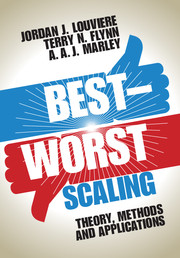Book contents
- Frontmatter
- Contents
- List of figures
- List of tables
- List of contributors to application chapters
- Preface
- Acknowledgments
- Theory and Methods
- 1 Introduction and overview of the book
- 2 The BWS object case
- 3 The BWS profile case
- 4 The BWS multi-profile case
- 5 Basic models
- 6 Looking forward
- Applications: Case 1
- Applications: Case 2
- Applications: Case 3
- References
- Subject index
- Author index
4 - The BWS multi-profile case
from Theory and Methods
Published online by Cambridge University Press: 05 October 2015
- Frontmatter
- Contents
- List of figures
- List of tables
- List of contributors to application chapters
- Preface
- Acknowledgments
- Theory and Methods
- 1 Introduction and overview of the book
- 2 The BWS object case
- 3 The BWS profile case
- 4 The BWS multi-profile case
- 5 Basic models
- 6 Looking forward
- Applications: Case 1
- Applications: Case 2
- Applications: Case 3
- References
- Subject index
- Author index
Summary
The corruption of the best things gives rise to the worst.
David Hume (1711–1776) (1889 [1757], sect. 10, 339)4.1 Introduction
This chapter describes and discusses the final BWS case (Case 3), which is the multi-profile case. This case is closely related to the literature on discrete choice experiments, with two key differences: (1) the response task associated with DCEs for this case is a choice of the best and the worst profile (and/or choices of the best and the worst profile plus second-best, second-worst, etc.); and (2) an emphasis on individual-level analysis. The plan of the chapter is as follows: we briefly review traditional DCE literature to provide some familiarity with this stream of research; we then show how Case 3 models logically extend prior work, and discuss departures noted above; we next describe, discuss and illustrate Case 3 design, implementation and analysis; and conclude with unresolved issues and future research opportunities.
DCEs are not new; the method of paired comparisons was formalized by Thurstone (1927). DCE developments since 1980 (1) concern multiple and paired choices, (2) rely on random-utility-theory-based probabilistic discrete choice models developed after 1970 (for example, McFadden, 1974), and (3) typically are constructed using principles from the design of statistical experiments. The latter stream of work was initiated by Louviere and Woodworth (1983), who pioneered a way to design multiple choice experiments consistent with McFadden's (1974) conditional logit model and more general models such as “mother logit” (McFadden, Train and Tye, 1978). Prior to Louviere and Woodworth (1983) there was little work on designed experiments for multiple choices, and researchers often used ad hoc combinations of pairs, triples, quadruples, etc. as choice experiments. Louviere and Woodworth provided a systematic way to design DCEs based on ideas from the design of statistical experiments. The focus in this chapter continues this tradition, and we describe and discuss relevant new developments when appropriate.
Recent reviews of DCE literature include those by Louviere, Hensher and Swait (2000), Louviere (2001), Louviere and Street (2000), Louviere, Street and Burgess (2003), Street, Burgess and Louviere (2005), Burgess et al. (2006), Street et al. (2008), Street and Burgess (2007), Louviere and Lancsar (2009) and Rose and Bliemer (2009). Thus, there is no need to review what is already well known and well worn, so we give only brief details when they are relevant.
- Type
- Chapter
- Information
- Best-Worst ScalingTheory, Methods and Applications, pp. 89 - 113Publisher: Cambridge University PressPrint publication year: 2015

